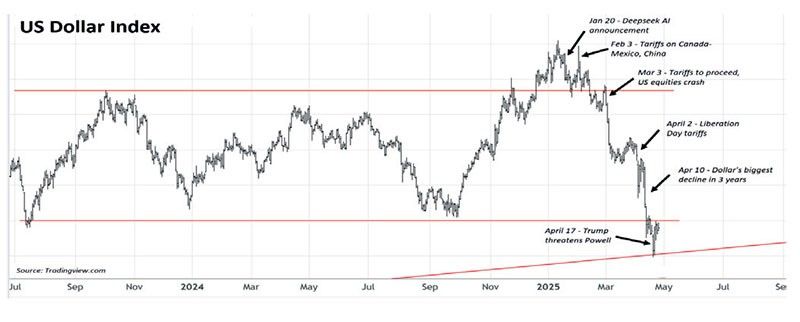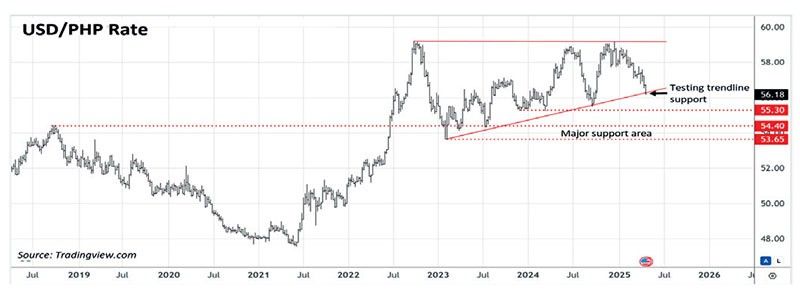
Upgrade to High-Speed Internet for only ₱1499/month!
Enjoy up to 100 Mbps fiber broadband, perfect for browsing, streaming, and gaming.
Visit Suniway.ph to learn
The US dollar’s long-standing role as the ultimate refuge during market storms is cracking. Traditional correlations have broken down as investors witnessed a rare triple-whammy in US stocks, bonds and the dollar falling simultaneously. This pattern shift has left many analysts questioning whether the world’s reserve currency has topped out after decades of dominance. While previous risk-off episodes sent capital flooding into US Treasuries and the dollar, the opposite is happening this time.
Exceptionalism fading
US exceptionalism – a topic we discussed last month – is showing signs of strain as the greenback declines under mounting pressure (see US Exceptionalism Falters as Markets Tumble, March 17, 2025). The currency that underpinned US outperformance in recent years shows signs of fatigue just as recession odds rise, trade tensions escalate and Chinese AI breakthroughs narrow the technology gap. Gold prices hitting $3,500 per ounce and German bunds attracting unprecedented inflows tell the story: the world’s frightened money is finding new shelters beyond US shores.
Chronology of collapse
The dollar’s recent decline reveals the sharp reversal of fortune:
Jan. 20: Coming from two-year highs, the US dollar index (DXY) plunges by 1.22 percent to 108.07 as DeepSeek AI’s breakthrough undermines US technological supremacy narrative.
Feb. 3: Dollar stages sharp reversal from 109.88 intraday high to close lower by 1.32 percent to 108.42 after Trump unveils 25 percent tariffs on Canada and Mexico, 10 percent additional tariffs on Chinese goods.
March 3: Beginning of a sharp five-day slide that drives DXY down by 3.4 percent to 103.91 after Trump confirms Canada-Mexico tariffs will proceed, erasing hopes for last-minute deal with the two US allies. US equities simultaneously erase all post-election gains.
April 2-3: Greenback falls further to 101.94 following Trump’s sweeping “Liberation Day” tariffs – 54 percent on China, 45 percent on Vietnam, 32 percent on Taiwan, even hitting allies with 25 percent for South Korea, 24 percent for Japan and 20 percent for EU. China’s retaliation with 34 percent counter-tariff and rare earth export restrictions accelerates the sell-off.
April 10: DXY suffers its steepest single-day drop since 2022, hitting a fresh year-to-date low of 100.91 amid rumors that China is dumping US Treasuries and buying European bonds.
April 17: Trump threatens to dismiss Fed Chair Powell over interest rate policy, sending DXY spiraling to 97.92, lowest since April 2022.

Potential regime change
We may be at an important inflection point. Market participants note the unprecedented nature of these recent moves – the dollar weakening precisely when traditional models predicted strength. Technical analysis shows that the DXY is now precariously holding major support at the 98-100 range. Note that currency trends last for a long time once directional momentum takes hold. This potential regime change demands close monitoring as currency cycles typically unfold over years, not months.
USDPHP rate tests trendline support
The Philippine peso has strengthened substantially amid the greenback’s fall, with the USDPHP rate now probing trendline support at around 56.20. While technical indicators suggest USDPHP should bounce from current levels, persistent dollar weakness could see the pair testing key support at 55.30 followed by the psychologically important 54.40 level.

Dollar king challenged – not dethroned
The US dollar’s reserve currency status, though weakened, remains intact. The US economy is still the largest with markets offering unmatched liquidity, depth and transparency. Despite recent declines, no other currency can yet match the dollar’s structural advantages in the global financial system. However, erratic policies and surprise announcements from Trump have spooked investors who are now increasingly diversifying, shifting capital into euros, yen, Swiss francs and European and Japanese assets. The shift extends beyond developed markets as JP Morgan has upgraded Philippine stocks to overweight, signaling growing investor confidence in emerging markets.
Sell America trade
Wall Street calls it the “Sell America” trade, capturing the market’s USA vs. the World sentiment. Protectionist “America First” policies have triggered a broad exodus from dollar assets, with investors simultaneously dumping US stocks, bonds and the currency itself. January’s tech shock and February’s tariff-induced slide appear to have marked the dollar’s cyclical peak. This does not signal the greenback’s demise, but rather a world where US exceptionalism and the dollar’s reign face unprecedented challenges.
Philequity Management is the fund manager of the leading mutual funds in the Philippines. Visit www.philequity.net to learn more about Philequity’s managed funds or to view previous articles. For inquiries or to send feedback, please call (02) 8250-8700 or email [email protected].

 2 days ago
3
2 days ago
3



